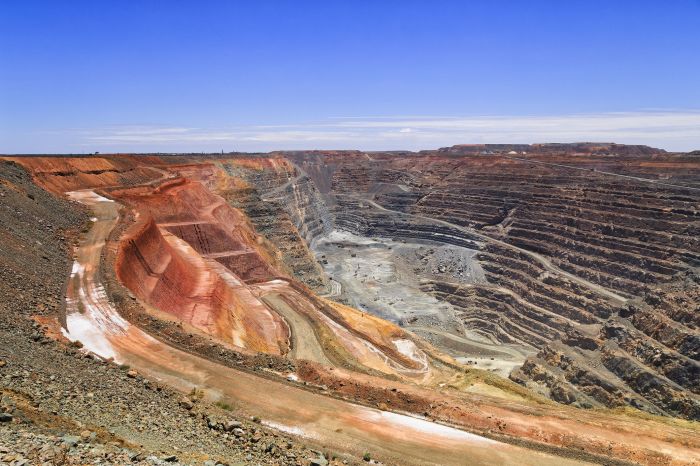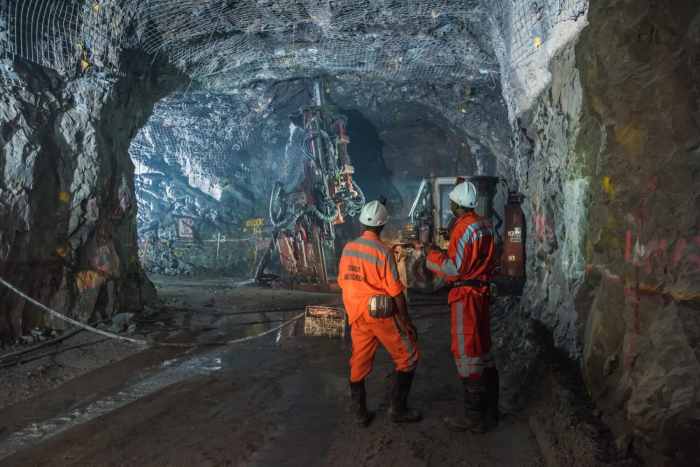Where do you mine iron? This question lies at the heart of understanding the intricate process of extracting one of the world’s most essential metals. From its geological origins to its diverse applications, the journey of iron ore is a fascinating exploration into the depths of our planet and the industries it shapes.
Iron ore, the primary source of iron, forms through complex geological processes and is found in various deposits around the globe. Its extraction involves a range of mining methods, each with its own advantages and environmental considerations. Once extracted, iron ore undergoes processing to transform it into usable iron, a vital component in steel production and countless other industries.
Iron Ore Deposits

Iron ore is a rock that contains iron oxides. Iron ore is the primary source of iron for steel production. Iron ore deposits are found in many parts of the world, but the largest deposits are found in Australia, Brazil, China, and Russia.Iron ore is formed when iron-rich rocks are weathered and eroded.
The iron oxides are then transported by water and deposited in layers. Over time, these layers become compressed and form iron ore deposits.
Types of Iron Ore Deposits
There are two main types of iron ore deposits:
- Magmatic depositsare formed when iron-rich magma cools and crystallizes.
- Sedimentary depositsare formed when iron-rich sediments are deposited in layers.
Magmatic deposits are typically found in igneous rocks, such as granite and basalt. Sedimentary deposits are typically found in sedimentary rocks, such as sandstone and limestone.
Regions with Significant Iron Ore Reserves
The countries with the largest iron ore reserves are:
- Australia
- Brazil
- China
- Russia
- India
These countries account for over 80% of the world’s iron ore reserves.
Mining Methods

Iron ore is mined using a variety of methods, including:
- Open-pit miningis the most common method of iron ore mining. In open-pit mining, a large pit is excavated in the ground and the iron ore is removed from the pit using trucks and shovels.
- Underground miningis used to extract iron ore from deposits that are located deep underground. In underground mining, shafts are sunk into the ground and tunnels are excavated to reach the iron ore deposit.
- In-situ miningis a method of mining iron ore that does not require the excavation of a pit or the construction of underground tunnels. In in-situ mining, chemicals are injected into the iron ore deposit to dissolve the iron oxides. The dissolved iron oxides are then pumped to the surface.
The choice of mining method depends on the size and location of the iron ore deposit, as well as the environmental regulations in the area.
Advantages and Disadvantages of Open-Pit and Underground Mining, Where do you mine iron
Open-pit mining is a more efficient and less expensive method of mining iron ore than underground mining. However, open-pit mining can have a significant environmental impact, as it can result in the destruction of habitat and the pollution of water and air.
Underground mining is a more environmentally friendly method of mining iron ore, but it is also more expensive and less efficient.
Environmental Impact of Iron Ore Mining

Iron ore mining can have a significant environmental impact. The mining process can result in the destruction of habitat, the pollution of water and air, and the generation of waste. The mining process can also lead to the release of greenhouse gases, which contribute to climate change.
Iron Ore Processing: Where Do You Mine Iron
Iron ore is processed into usable iron through a series of steps. These steps include:
- Crushing: The iron ore is crushed into smaller pieces.
- Beneficiation: The iron ore is beneficiated to remove impurities, such as silica and sulfur.
- Pelletizing: The iron ore is pelletized to make it easier to handle and transport.
- Sintering: The iron ore is sintered to make it more porous and easier to reduce.
- Reduction: The iron ore is reduced to produce iron metal.
The reduced iron metal is then used to produce steel.
Role of Iron Ore in Steel Production
Iron ore is the primary source of iron for steel production. Steel is an alloy of iron and carbon. Steel is used in a wide variety of applications, including construction, automotive, and manufacturing.
Global Iron Ore Market

The global iron ore market is a complex and dynamic market. The price of iron ore is influenced by a variety of factors, including the supply and demand for iron ore, the cost of production, and the global economic conditions.The major iron ore producers are:
- Australia
- Brazil
- China
- Russia
- India
The major iron ore consumers are:
- China
- Japan
- South Korea
- India
- United States
The global iron ore market is expected to grow in the coming years, as the demand for steel continues to increase.
Iron Ore Exploration
Iron ore exploration is the process of searching for iron ore deposits. Iron ore exploration is a complex and challenging process. The exploration process can involve a variety of techniques, including:
- Geological mapping: Geological mapping is the process of creating a map of the surface geology of an area.
- Geophysical surveys: Geophysical surveys are used to measure the physical properties of the earth’s crust.
- Drilling: Drilling is used to collect samples of the earth’s crust.
The exploration process can be time-consuming and expensive. However, it is essential for the development of new iron ore mines.
Challenges and Risks of Iron Ore Exploration
Iron ore exploration is a challenging and risky process. The challenges and risks of iron ore exploration include:
- The cost of exploration: Iron ore exploration can be a very expensive process.
- The time required for exploration: Iron ore exploration can take many years.
- The risk of not finding an iron ore deposit: There is always the risk that an iron ore exploration project will not find an iron ore deposit.
Despite the challenges and risks, iron ore exploration is an essential process for the development of new iron ore mines.
Iron Ore Applications
Iron ore is used in a wide variety of applications, including:
- Construction: Iron ore is used to produce steel, which is used in the construction of buildings, bridges, and other structures.
- Automotive: Iron ore is used to produce steel, which is used in the production of cars, trucks, and other vehicles.
- Manufacturing: Iron ore is used to produce steel, which is used in the production of a wide variety of products, including appliances, machinery, and tools.
Iron ore is also used in the production of iron castings, which are used in a variety of applications, including the production of pipes, valves, and fittings.
Potential for New Applications of Iron Ore
There is potential for new applications of iron ore in the future. For example, iron ore could be used to produce hydrogen, which is a clean-burning fuel. Iron ore could also be used to produce new materials, such as graphene, which is a strong and lightweight material.
Top FAQs
What are the major iron ore producing countries?
Australia, Brazil, China, India, and Russia are the top iron ore producing countries.
How is iron ore processed into usable iron?
Iron ore is processed through a series of steps, including crushing, beneficiation, and smelting, to extract the iron content.
What are the environmental impacts of iron ore mining?
Iron ore mining can impact air and water quality, disrupt ecosystems, and generate waste.
